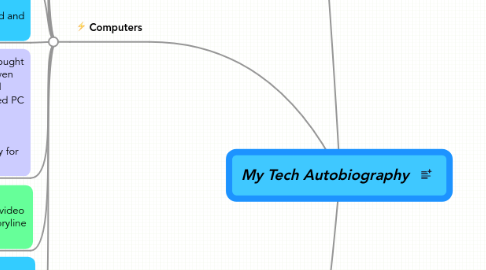
1. Computers
1.1. 1984, used a mac for the first time
1.2. In 1985, my kindergarten class went on trips to NASA, and stimulated my interests in space travel, science fiction, and science/technology
1.3. in 1990, used computers in elementary P.S. 164 4th grade class in Astoria NY 5th and 6th grade in P.S. 209, Played "Oregon Trail", "Sim City", "Math Blaster"
1.4. in 1992, played computer games extensively with my friend Max Sweeney. His father was one of the digital artists involved in the making of the Polar Bear Coca Cola commercial.
1.4.1. Game gear was introduced to me by Max; I played and beat the game "Shining Force"
1.5. In 1995, my stepfather had a computer with which I could play Sim City 2000.. I played for countless hours and filled my city with acropolises.
1.6. In 1996, I was introduced to the game "Diablo". this game really had me hooked and triggered my interest in hacking culture
1.7. In 1998, I purchased my own computer and bought books on graphics design, web design, and even interned for a graphics design company called "AD/FX". They were Mac based, but I preferred PC because it allowed me access to more pirated software so I could learn it. Also, Mac did not support Cakewalk, and all MIDI software that I used on it was not as intuitive and user friendly for me.
1.7.1. My philosophy on piracy is, if the software allows me to accomplish what I want it to, then buy it; they deserve the money. If it doesn't, they don't lose anything in me pirating it because I wouldn't have bought it even if I had the money. Thankfully I had the software long enough to find out whether it works for me or not, whether or not it produces results. Trial versions never gave me long enough time to decide.
1.8. In 1999 I formed a graphics design group called "Manifest Destiny", a website centered around a video game that we were developing characters and storyline for.
1.9. My passion for video games and it's music prompted me to consider the process of video game development in that area, and I had no knowledge of the technology involved in the process until I came across a program in my local community college for Music Electronic Technology. I began improving my computer hardware skills and incorporating music equipment in the form of various soundcards with MIDI libraries built in. I discovered that Sound Blaster Audigy cards had an impressive set of MIDI instruments with analog outputs that connected easily to my old reciever.
2. Music Composition and MIDI Sequencing
2.1. Wrote my first work in a music tech lab at Queensborough Community College with software called "freestyle" in 1999
2.2. Discovered the software that would change my life forever; "Cakewalk". I purchased it off the street for $10 from a software pirate in SOHO right on the corner of West Houston Street and Broadway. I had no prior experience composing, but upon using its interface, I felt it was intuitive and easy for me to use given its icons, color based instrument identifiers, a musical staff view, and the "Matrix" or "Piano Scroll" view.
2.2.1. Cakewalk allowed me to compose music with relative ease; no extensive musical training required. My main musical interest is "Video Game Music". Having played so many video games, I was weird enough to pay attention to something I noticed most people did not; the music. I would go on to write my NYU Master's thesis on video game music. I built the website myself using dreamweaver.
2.2.1.1. This is my published master's thesis. It is provided to all by www.vgmusic.com, which is a video game music MIDI site where people can download community arranged MIDI scores of classic and current video game music. Video game music companies are often reluctant to provide musical scores, so there are communities that arrange them by ear.
